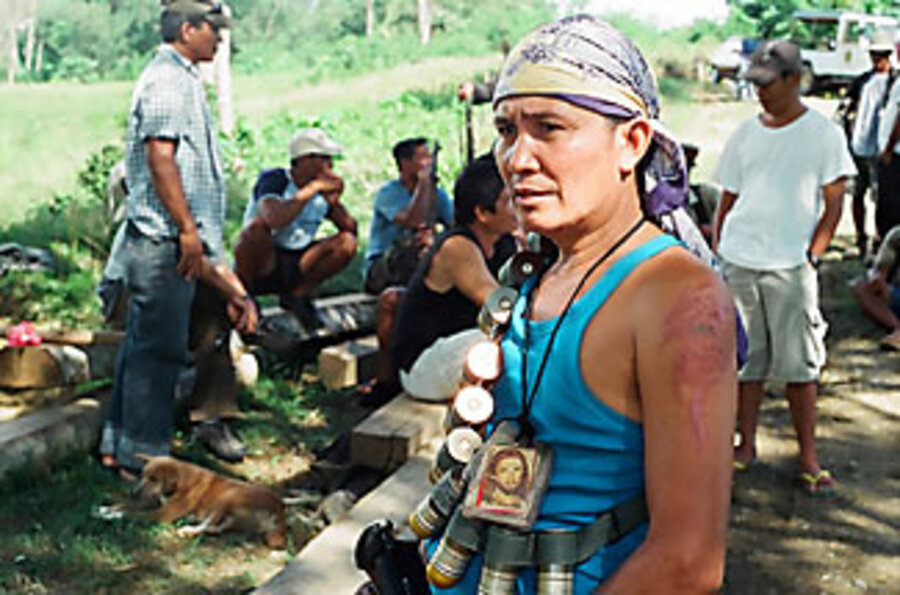Filipino Christian vigilantes get set for battle
Loading...
| Aleosan, Philippines
On a muddy, shaded track between fertile farmlands, 30 men lounge in flip-flops and tattered camoflauge, displaying their beaten-up M-16 and AK-47 assault rifles.
They call themselves ilaga or "rats" in a local Philippines dialect. They're vigilantes: Christian farmers who have taken up arms to protect their land and families against Muslim rebels in this troubled corner of the southern Philippines.
Most have no military training, says their puckish leader Felimon Cayang, who styles himself "Commander Max." He shows off his souped-up M-16, tattoos, and religious "amulets" – patches tied to his necklace and underwear bearing images of Jesus and the Virgin Mary and worn for protection in battle.
He says his group held their own in a day-long firefight in July with a much larger group of Muslim rebels led by Commander Umbra Kato, just a few miles away.
They suffered no casualties. As for the other side, Commander Max says with clear satisfaction, "I don't know how many we killed, but we found blood."
Here on the island of Mindanao, such Roman Catholic vigilantes haven't been a force since the 1970s, when all-out communal war raged. Their return now, some 30 years later, is a sign of a society that's again become dangerously polarized along religious lines.
It's one sad consequence of the breakdown of peace talks between the Philippines government and the Moro Islamic Liberation Front (MILF). Four months after talks broke down, the military is still engaged in a deadly, cat-and-mouse game with three "rogue" commanders, including Mr. Kato. Hundreds of thousands of Muslim civilians remain in makeshift camps, afraid to return to their homes. And Malaysian monitors who helped enforce a cease-fire left Nov. 30 after their mandate expired.
With the peace process in tatters and no clear way forward, many fear that the gains of 11 years of negotiations are fast disappearing amid recriminations and communal mistrust.
"The opportunity for a democratic and peaceful solution to the conflict is becoming narrower and narrower," says Abhoud Lingga, director of the Institute for Bangsamoro Studies in Mindanao. "For us peace advocates, this is alarming."
The town of Aleosan lies on the faultline of communal divisions in Mindanao. The Moros – as Muslims here call themselves – regard this and surrounding areas as part of their ancestral homeland. But much of Aleosan's land has now been owned and farmed for decades by Christians from the central Philippines, who settled here after World War II with government encouragement.
Sitting in his sunlit office here, Aleosan mayor Loreto Cabaya says he helped organize a civilian militia – including some ilaga – to prevent Muslim rebels from grabbing land ahead of a peace deal. The deal, which was supposed to be signed this past summer, envisioned an expanded Muslim autonomous area with greater control over its resources and revenue. Seven of Aleosan's 19 barangay (villages) – those with Muslim-heavy populations – looked set to become part of that Muslim area.
It never happened. Instead, the Philippines Supreme Court issued an 11-hour injunction blocking the government from signing the deal. Later, it ruled the deal unconstitutional, arguing it would have effectively partitioned the Philippines.
Mr. Cabaya agrees. He says he can accept giving the Muslims more land and autonomy, but he thinks the proposed deal went too far. "I think the conflict will be worse if demands of the MILF are met, because their demand is [for] a separate state," says Cabaya. "It's being disguised as autonomy, but in essence it's a separate state."
Opposition from Christian leaders like Cabaya helped scuttle the deal. Getting them on board in any future peace process will be critical.
When the two sides do get back to the table, there will be a lot of trust to rebuild. After being burned by the Supreme Court, the MILF now has little faith that the Philippines government is a reliable negotiating partner. "We can resume talks," said MILF spokesman Eid Kabalu. "But we doubt very much [that] we can achieve a satisfactory and viable outcome."
Analysts are skeptical, too. "The fundamental problem is, how do you create an autonomous Islamic region in Mindanao that's satisfactory to everyone?" says Scott Harrison, managing director of Pacific Strategies and Assessments, a Hong Kong-based risk consultancy. "If you limit it to areas of overwhelming Muslim presence, you could probably sell that. But once you get into marginal areas, it's increasingly difficult."
Aleosan is one of those areas. It's still clearly on edge. Government howitzers in a neighboring town guard against more rebel incursions. Mayor Cabaya is shadowed by two M-16-toting bodyguards, whom he's retained since tensions began this summer. "We haven't let down our guard – they're still out there," says Cabaya, referring to the rebels.
The ilaga are also keeping their powder dry. They're a ragtag bunch, some in their 60s and even 70s – veterans of the vicious 1970s vigilante wars here. They keep a wary watch over their farmlands, fearing another round of fighting – especially now that international monitors have left.
"Both sides are always preparing," says Eduardo Cabaya, who doubles as a municipal councilor. "As long as Umbra Kato is out there, we'll be here."






